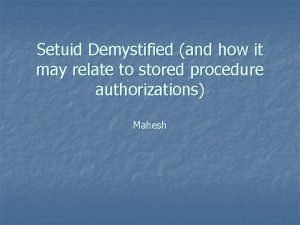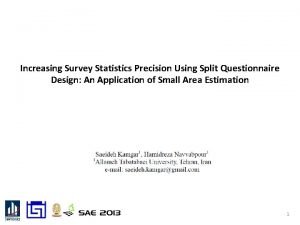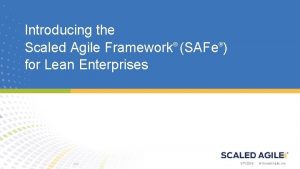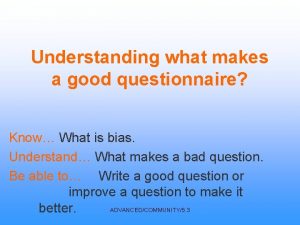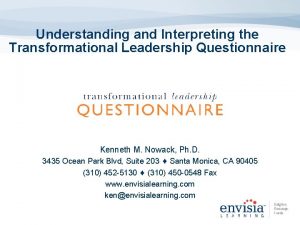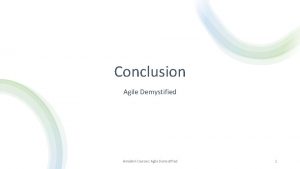Agile Questionnaire Introduction Agile Demystified Amadori Courses Agile














- Slides: 14

Agile Questionnaire - Introduction Agile Demystified Amadori Courses: Agile Demystified 1

Introduction • We are approximately halfway through this course, in terms of content at least. • You should by now have a clearer understanding of what the detail of each of the 12 Agile principle involves • And picked up a broad sense of why the Agile Manifesto is written the way it is Amadori Courses: Agile Demystified 2

In Summary The Agile Manifesto was written by people actively engaged in delivering software Amadori Courses: Agile Demystified Who sought a better way of dealing with ever changing requirements 3

Delivering smaller releases more often They sought to manage change better by Trusting their delivery teams by • Devolving decision making to the delivery teams as they are closest to the detail of the release • Promoting informal collaborative working arrangements Amadori Courses: Agile Demystified 4

Remember • The 4 guidelines and 12 principles of the Agile Manifesto are designed to be read in unison • Each element supports the others and only by FULLY implementing all 12 principles and adhering to all 4 guidelines will a project/organisation truly be “Agile” Amadori Courses: Agile Demystified 5

What happens next Together we will work through the detail of a questionnaire which principle by principle enables you to assess exactly where your project or organisation currently stands in relation to the adoption of Agile processes And allows you to do so in an objective and repeatable manner Amadori Courses: Agile Demystified 6

Categories • Your responses to the Questionaire will allow you to place each Principle into one of three categories • 1. There or Almost There • 2. Possible, but significant work required • 3. Agile probably isn’t for you (at the moment at least) Amadori Courses: Agile Demystified 7

• Your current process is either 1. There or Almost There • Already following agile principles Or • Would require only minor adjustments to become Agile compliant Amadori Courses: Agile Demystified 8

2. Possible, but significant work required • Your current process is not Agile but could be made so with significant investment of time and resources • Whether this investment would pay off in the long run would depend both on 1. How much else of the Agile Manifesto you are able to implement 2. The expected long term payoff from making this change in isolation Amadori Courses: Agile Demystified 9

3. Agile probably isn’t for you (at the moment at least) • Your project or organisation is currently setup in such a way that adopting agile processes would involve a fundamental change in the management philosophy of the organisation and its entire approach to delivery • Piecemeal adoption of elements of the Agile Manifesto are also likely to prove unsuccessful unless the overall philosophy of the company changes Amadori Courses: Agile Demystified 10

• Largely Green Overall Assessment • Your project/organisation is likely to see significant benefits in the short to medium term from adopting a fully agile process Amadori Courses: Agile Demystified 11

• Mixed Orange/Green Overall Assessment • Benefits from adopting agile processes are still possible but will take longer to accrue depending on the type and volume of process changes you are required to make Amadori Courses: Agile Demystified 12

• Mainly Orange Overall Assessment • Attempting to go fully Agile is only recommended if there is a serious long term commitment by the organisation as a whole to support the change as the benefits from agile will generally only arise in the medium to long term and follow significant teething problems during the conversion process Amadori Courses: Agile Demystified 13

• Red Overall Assessment • Even a single Red result may be enough to mean that it is not feasible for that project/organisation to follow agile processes at that moment in time • This is because Red categorisation generally highlights a fundamental incompatibility between the way the whole organisation manages change and the delivery process currently with the devolution of decision making and responsibility advocated by the Agile Manifesto • Unless attempted in a context where there is a willingness to devolve decision making to delivery teams any attempt to implement Agile will almost certainly fail Amadori Courses: Agile Demystified 14
 Amadori report
Amadori report Pollo broiler wikipedia
Pollo broiler wikipedia Erp demystified
Erp demystified Erp demystified
Erp demystified Setuid demystified
Setuid demystified Erp demystified
Erp demystified Erika chin
Erika chin Introduction of questionnaire
Introduction of questionnaire Introduction to agile testing
Introduction to agile testing Relentless improvement safe
Relentless improvement safe Thésée revenu des enfers questionnaire
Thésée revenu des enfers questionnaire Prise de pouls chinois
Prise de pouls chinois What makes a good questionnaire
What makes a good questionnaire Transformational leadership questionnaire
Transformational leadership questionnaire Title for questionnaire
Title for questionnaire




